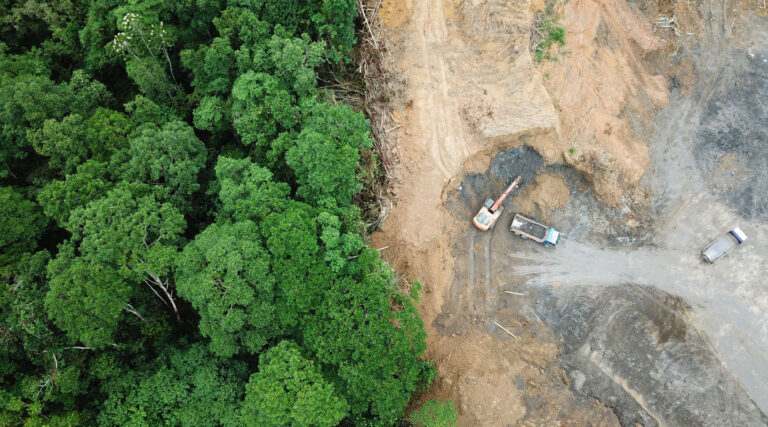For millennia, humankind’s survival and advances have depended on the discovery and use of abundant natural resources. Since the industrial revolution, the consumption of the Earth’s natural resources has accelerated exponentially, widely acknowledged as unsustainable in the long term.
Resource depletion has massive implications for all living things on Earth. The geopolitical effects of resource scarcity are already being felt, and the sudden unexpected loss of energy, mineral, water, and soil resources that are integral to the way of life of people across the Earth has the potential to devastate nations.
This article explains why and how natural resources are being depleted, with examples of some of the Earth’s most critically depleted natural resources.
What are natural resources?
Natural resources are resources that are available in our environment that can be extracted and utilized with little or no modification. The Earth’s natural resources include:
- Sunlight
- Air
- Water
- Vegetation
- Wildlife
- Minerals
We can divide natural resources into some distinct segments. Broadly, these are:
- Biotic resources, which include living things
- Abiotic natural resources, derived from non-living or inorganic sources like metals, ores, fossil fuels, and minerals
Mankind uses these naturally occurring substances, materials, and organisms for food, shelter, energy, and a wide range of industrial and commercial endeavors.
Natural resources belong to everyone
Natural resources are a heritage that should be shared by humanity and sustained with appropriate stewardship, but sadly this has not been the case. These resources have been mined, chopped down, processed, cleared, and polluted to sustain wide-ranging corporate and political interests, which have served few people at the expense of the rest of mankind.
It is, in fact, these groups who are now the first to decry the depletion of natural resources and assert their authority over and ownership of what remains. And the stakes are high because resource scarcity precipitates conflicts and is a key driver of poverty and disease.
What is causing natural resource depletion?
Using natural resources is part of typical daily life for every creature on Earth. It is unavoidable as every person needs to breathe, eat, and access clean water and safe shelter.
So there must be other drivers of the accelerated depletion that is taking place; here are some suggestions:
Excessive consumption
Some people have suggested that there are too many people on Earth and that a population of billions of people simply cannot be sustained. But if you look at a list of countries that consume the most natural resources, not everyone is consuming equally. It is clear that consumption is heavily skewed towards the more economically advanced nations rather than the most populous ones.
A list of countries that use the most resources per capita:
- Qatar
- Luxembourg
- UAE
- United States
- Canada
These five countries manage to use a year’s worth of natural resources within just three months. Modern, technologically advanced lifestyles that prioritize convenience lead to high consumption that is hard to curb because it is profitable. So it’s clear that population is not the driver of resource depletion mankind has to be concerned about.
Excessive waste
Natural resources are being extracted from the environment at such an alarming rate because a large proportion of the resources are being wasted. Waste is a global problem that affects every type of natural resource, as newly extracted ones are still replacing unused resources. Examples of this wastage include
- Energy wastage: 58% of the energy generated in the United States is not put to productive use. Domestic and commercial energy efficiency in the U.S. is only 42%. This is a serious problem because the U.S. is a major producer and consumer of non-renewable fuels like oil and natural gas.
- Food waste: More than a third of all the food produced in the world is wasted. This amounts to over 2.5 billion tonnes of food that will hit the landfill or rot in fields. China and India have the greatest amount of household food waste. This is a problem because food production uses many natural resources, including phosphorous, for fertilizer which is becoming increasingly scarce.
- Wastage of materials: Only 19% of the world’s waste is recycled. This means that there is a shocking amount of frank waste of products and materials derived from natural resources.
The habitual discarding of products that are broken or used in municipal waste as well as the lack of a concerted effort to recycle them drives demand for further raw materials, depleting natural resources.
Pollution
Pollution of land, air water, and the subsequent environmental degradation lead to essential natural resources becoming depleted or unusable. Heavy industries that extract natural resources like mining and oil and gas, impact other natural resources through deforestation, land pollution, and groundwater contamination.
Industrialization
Industrialization has elevated the standard of living of billions of people around the world, but its aggressive pursuit and exploitation of natural resources have driven the advanced depletion of natural resources.
Industrialization in its current form is heavily reliant on the consumption of non-renewable natural resources like oil, gas, minerals and metals. As countries become increasingly industrialized, global demand for these natural resources is pressuring known reserves leading to scarcity and increased competition for them.

The pursuit of profit
Natural resources are exploited to excess because it is profitable to do so. Large multinational corporations and their financial backers derive their profit from continually extracting natural resources, using them to manufacture products, and selling them to consumers. For profits to be sustained this process has to be continual, to the detriment of the environment.
To make money, consumer appetites and expectations have been deliberately shaped over decades to drive demand. Companies have also gained control of key natural resources like oil and gas and monopolized them, creating derivative products that are then marketed as essential to keep consumption going.
The displacement of people also drives natural resource depletion
Population shifts caused by war and poverty are also important drivers of the environmental degradation that leads to natural resource depletion. Unique and fragile ecosystems can be rapidly destroyed by displaced peoples who clear forests for subsistence farming or to obtain firewood. This type of depletion is driven by need, but it is extensive with up to 40% of tropical deforestation undertaken by people who want to use the land for subsistence.
How can we tell which natural resources are being depleted?
Depletion accounting (also known as green accounting) provides a model for qualifying the extent, impact, and financial cost of natural resource depletion.
By placing the value of the environment and its natural resources on an equal footing with financial assets and the market economy, financial analysts can track the rate of depletion of specific natural resources and weigh the economic impact of their loss.
Analysts use data from countries to calculate the quantities of natural resources like fossil fuels, minerals, lumber, productive agricultural land, and water. These natural resources are termed natural capital, and their rate of depletion can be carefully tracked against demand and their value on the global market.
Depletion accounting has proven effective in demonstrating the impact of resource extraction industries in developing countries, where mining and other extraction activities form a large proportion of the overall economic output.
This form of accountancy can also be used to see how dependent countries are on non-renewable resources and help them identify sustainable alternatives.
Why is the depletion of natural resources a cause for concern?
Depletion of natural resources has become pervasive. Without intervention, many critical resources could become extinct within a generation. An important issue is not only the available quantity of natural resources like oil and coal, but also how easily proved reserves can be accessed to be used.
To give you an idea of the current extent of resource depletion, here are 11 examples of natural resources that are in decline:
1. There are only 21 years of recoverable coal reserves at active U.S. mines
The United States has the world’s largest share (22%) of proven coal reserves, but readily accessible coal in working mines is becoming depleted. According to the U.S. Energy Information Administration, there are just over 20 years of coal in producing mines if production continues at the annual rate of 0.577 billion short tons.

Source: Wikimedia / Mr. Satterly
The 1975 U.S. Geological Survey (USGS) suggests that the U.S. should have another 435 years of coal reserves, but this would require additional exploration and new mining operations that are acknowledged to be heavily polluting.
Another concern is that only 5 countries (United States, Russia, Australia, China, and India) have 75% of the world’s coal. As other countries industrialize and coal demand increases depletion of these reserves will accelerate with India already affected by an unprecedented deficit of their coal stocks and shortages of coal for power plants.
2. At current consumption rates, there is only a 50-year supply of oil left
Worldometer reports that the proven reserves of oil, estimated at 1.65 trillion barrels in 2016, are only sufficient for 46.6 years of consumption at current levels.
This estimation depends on whether oil consumption continues at the current rate. Consumption by lower and middle-income countries is expected to increase from 99.4 million barrels in 2022 to over 104 million barrels in 2024 as they industrialize their economies.
3. United States natural gas supplies are expected to last less than a century
Though the natural gas reserves of the United States are vast, they are not infinite. Continuance of the 2016 rate of natural gas consumption at 27.5 Tcf per year will exhaust the domestic proven and unproven natural gas resources within approximately 90 years.

Domestic natural gas consumption has increased in America with the introduction of shale rock extraction and a preference for natural gas because of its low emission. However, switching to a majority-methane economy would accelerate the depletion of these reserves.
Globally, the BP Statistical Review of World Energy reports that natural gas reserves may only last 49 years. However, these estimates do vary with production levels and the discovery of new reserves.
4. A third of the world’s forests have been lost to deforestation
Deforestation has been going on for millennia, leading to the loss of up to a third of the world’s forests at the present day. Over centuries, man has progressively cleared forested areas to make way for various forms of agriculture.
In the 20th century, deforestation dramatically accelerated with rapid population growth. Land clearance for agriculture, illegal logging, and poorly planned infrastructure projects have led to the loss of 10 million hectares of forest each year.

Source: Wikimedia / Neil Palmer (CIAT)
This loss of forest is devastating. Not only is there the loss of vital habitat for wildlife, but the Earth’s forests are also a natural sink for carbon dioxide and cleanse and purify the air. Trees are vital for soil structure and integrity, and when they are removed, the valuable topsoil is washed off and the land rapidly degrades.
Extensive removal of trees destabilizes the surrounding earth and in sloped or hilly places can lead to landslides. The 2017 fatal landslide in Sierra Leone has been attributed to the loss of over 800,000 hectares of forest cover within a decade.
Deforestation also negatively impacts people and has many social, economic and health consequences for human livelihood.
5. Groundwater depletion threatens the water supply for over half the U.S. population
Just 2.5% of the water on Earth is freshwater, making groundwater supplies an extremely precious resource. In the U.S., groundwater depletion, with a long-term decline in the water table level, is a recognized problem that threatens the millions of U.S. citizens that rely on it for domestic use.
Half of the U.S. population, including the entire rural population, uses groundwater daily. In addition, sustained groundwater pumping for agriculture tops 50 billion gallons of water daily. This has led to overdrafting, the removal of water beyond the equilibrium yield and the recharge rate of aquifers, leading to their depletion.
This problem affects many areas of the United States, with evidence of groundwater depletion, including wells drying up, reduction in the volume of water in streams and lakes, and deterioration of the quality of drawn or pumped water. Where pumping is excessive, it can even draw in saltwater, contaminating the freshwater.
6. A global shortage of phosphorous threatens crop yields
Global production of phosphorous, a key component of conventional NPK fertilizers, is expected to peak in 2030. Phosphorous is a finite natural resource concentrated in rock form only in Morroco and a few other places.

Source: Wikimedia / Alexandra Pugachevsky
Phosphate shortages have been thought to have been imminent since 2010, but a more recent evaluation of Morroco’s resources suggests that production of rock phosphate will peak by 2030. This is concerning because phosphorous is essential to plant growth, with vegetation having an increased demand for this mineral as atmospheric carbon dioxide levels rise.
A fall in phosphorous availability or rising prices could threaten food security and crop yields in developing countries.
7. Continual increases in demand threaten to decrease reserves of rare earth metals
Rare earth elements are a group of 17 heavy metals that have properties that are valuable in a wide range of electrical and electronic applications including, computers, lasers, magnets, and batteries.
The rise of technology has led to a massive increase in demand for rare earth, with 10% increases year on year. Though rare earth elements aren’t particularly scarce, the high rate of consumption by the electronics sector, and limited recycling of electronics means that global rare earth reserves could be completely depleted when we reach the 2050s.
China has the world’s most abundant rare earth element reserves, providing more than 97% of the global supply. The extent of Chinese rare earth resources is not fully known, but mining these metals has caused extensive soil and water pollution due to leaching pools filled with toxic chemicals to separate the metals from the earth.
8. Soil humus decline threatens soils viability worldwide
Organic matter in soils, known as humus, is a natural resource essential for rich and fertile land that can sustain crops, trees, and vegetation. This soil component includes not only decayed and rotting matter but also the diverse ecosystem of microorganisms that degrade the organic matter and maintain soil health.

Deforestation, intensive agriculture, land pollution and climate stressors have led to the depletion of soil humus. This is important because soil is one of the most important carbon sinks and a reservoir of nutrients essential for plant health. The humus layer of the soil also holds and filters massive amounts of water, up to six times its weight.
The carbon and nutrient content in soils is vital for sustainable agriculture. Farming sterile, dead soils relies entirely on fertilizers and heavy irrigation and, over time, leads to diminished yield and food insecurity. The loss of peat moss and other humus-rich soils also strips environments of vital habitats and a prime nitrogen store.
9. Zinc reserves are expected to start declining 30 years
Zinc is one of the world’s most used metals, after iron, aluminum, and copper. Zinc’s utility in solar panel and battery manufacturing has driven up demand in recent years. The metal is increasingly recognized as essential to implementing Net-Zero objectives, and demand for zinc may triple by 2030.
But zinc reserves are becoming depleted, with production shortfalls expected in the coming years. This scarcity has led to zinc being placed on critical minerals lists and market prices for this metal rising sharply. After peaking in 2050-60, zinc reserves are expected to decline sharply.
The depletion of zinc reserves also has implications for human health, as zinc plays an important role in normal immune function deficiency has been implicated in childhood mortality. The UN suggests that improved access to zinc could save the lives of up to 200,000 children.
10. Two-fifths of the world’s plant species are at risk of extinction
The Earth’s biodiversity is one of its most important but threatened natural resources. Plant species are under attack from land clearance and development, land pollution, monoculture and climate change. The depletion of plant biodiversity could lead to the loss of:
- Up to 200,000 edible plant species
- Medicinal plants and herbs
- Undiscovered plant species
- Plants and fungi that are essential to soil health and ecosystem stability

Though targets have been set to protect wildlife and ecosystems, in 2020, no single government managed to achieve them. Plant natural resources are believed to be largely untapped, and humanity is missing an opportunity to find foods and medicines that could sustain future generations.
11. Fish stocks may collapse by 2050
The industrialization of fishing has led to systemic overfishing that is rapidly depleting the world’s oceans. Some marine biologists are concerned that seafood stocks may not even survive the century.
Fish stocks are currently being harvested at unsustainable levels. The UN’s Food and Agriculture Organisation suggests that up to 90% of the leading commercial fish stocks have been fully exploited. An example is the prized bluefin tuna population that has suffered a precipitous fall of over 97% in recent years.
Despite efforts to curb overfishing, many nations are actively subsidizing industrial trawler fleets that decimate marine life.

Can anything be done to mitigate the loss of natural resources?
The depletion of Earth’s natural resources is taking place on a massive scale. But there is always something that can be done to stem these shocking losses.
Remedial action needs to take place at a local, national and international level, honestly addressing the financial and commercial drivers of natural resource depletion and potentially redirecting commercial activity towards strategies that curb excessive exploitation and consumption of our resources. Here are some ideas:
- Companies invest in recycling: Companies that extract and process natural resources should lead investment in recycling technology and facilities to ensure that these finite materials are reused as much as possible.
- Reprocessing waste: Instead of digging up earth for metals and minerals, mining companies could develop technology for reprocessing waste to recover the valuable materials that are simply landfilled. Landfills could become industrial sites where waste is sorted and ‘mined’ for usable materials, decreasing their volume and environmental impact long term.
- Circular economy: The circular economy, where goods are routinely reused, repaired, refurbished or recycled will eventually lead to a reduction in demand for raw materials and slow the depletion of natural resources.
In conclusion
Natural resources are a vital heritage for the present and future generations. Addressing this catastrophic decline in natural resources requires the shared acknowledgment that the current consumption levels are unsustainable and often unnecessary.
Rather than seeing the required change as arduous, changing our consumption patterns is an opportunity to develop new technologies and solutions to help everyone make the most of our current resources without looking for more!













